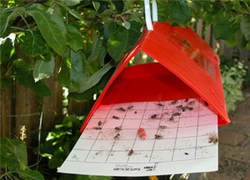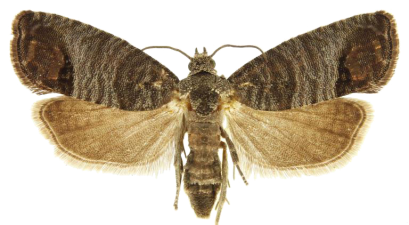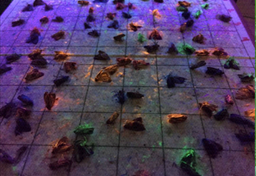 Pheromone trap for codling moth detection in apple orchards Pheromone trap for codling moth detection in apple orchards Written by: Veronica Yurchak & Anthony Nearman Managing a crop pest means more than simply spraying fields with insecticides. What and when to spray, how much, and where to apply chemicals are all questions that any successful pest control must address. To further complicate things, the answers to those questions will change with any given pest. How then do we confront the vast number of pests plaguing our agricultural systems? Dr. Jim Miller believes he has an answer, and it begins with sex. During a seminar at the University of Maryland On Friday October 5th, 2018, Dr. Jim Miller presented his work studying the use of sex pheromones to trap insects. For many years Dr. Miller has been investigating insect pheromones and the methods he has developed have the potential to reduce the volume of chemicals sprayed within a number of cropping systems. By cutting down on pesticide use, we’re not only being more environmentally friendly, but considerate to our wallets as well. Since the discovery and identification of insect sex pheromones in the late 1960’s, researchers quickly saw the benefits of deploying these chemicals in our agricultural systems. They act as lures and can be a powerful tool to survey the pest population a given area. Dr. Miller’s work provides a framework connecting the number of insects caught in a trap to the number of pests posing a hazard to a crop.  Figure 2. Codling moth – Cydia pomonella Figure 2. Codling moth – Cydia pomonella Currently, pest management decisions about pheromone-baited traps are based on Experienced-Based Relative Thresholds of catch, or previously determined catch number thresholds, where a pesticide treatment is recommended any time the number of insects caught exceeds that threshold. The number of pests caught in the trap over a given time period informs the grower roughly how many pests are present in the landscape. However, Dr. Miller suspected that the Experience Based Relative Thresholds commonly used were too low, resulting in the over-application of pesticides. To investigate this problem, Dr. Miller first turned to computer simulations. He hypothesized that if we could model the behavior of a pest prior to it detecting a pheromone plume, we could estimate the chances the insect will end up in a trap, thus would more accurately calculate the number of pests per acre using count data from pheromone traps. Observational studies previously performed by Dr. Miller have shown that the codling moth, Cydia pomonella, moves randomly from one direction to the next in the absence of an attractant. However, because the number of such choices a moth can make are limited, the outcome follows a common mathematical distribution called a standard bell curve. Armed with probabilities of directional choice, Dr. Miller executed a series of computer simulations and generated equations predicting codling moth behavior at various infestation levels. The next step was to head to the field and put these equations to the test.  Figure 3. Color-coded moths used to determine individual point of release in field experiments. Figure 3. Color-coded moths used to determine individual point of release in field experiments. The field tests for these equations were extremely large in scale, some releasing up to 800 male codling moths per release site! With the help of a graduate student, Dr. Miller and his team color-coded and released codling moths in various crop systems, replicating each experiment many times over. The moths were color-coded to their exact point of release within each crop system allowing the team to determine the distance and time each moth traveled before landing in a trap. After completing and analyzing the results from 155 experiments, Dr. Miller was excited to find consistent similarities in the results of his computer simulations and what was measured in the field experiments. Manipulating equations he had previously derived using his computer simulations, Dr. Miller discovered he was now able to propose a model that extrapolates absolute densities for codling moths based on catch numbers in pheromone-baited traps. In the end, Dr. Miller concluded that the number of male insects within the trapping area, or absolute pest density, was a function of the pheromone trap catch divided by the combined probabilities of trap findability, efficiency and retentiveness. Using these and other calculations, Dr. Miller has discovered a way to more accurately determine the actual amount of pest pressure within a given system, resulting in a way to more confidently determine when – and more importantly when not – to make a pesticide application. He has also refined insect trapping methods and determined that, though pheromone traps are an incredibly useful tool for insect pest management, trap catch is highly variable and single trap catch should therefore not be used as the basis for any management decisions. Instead, multiple traps should be set nearby one another in a method that Dr. Miller likens to long line fishing. The average catch of all traps should instead be used to inform management decisions. More information on line trapping of codling moth can be found in Dr. Miller’s recent publication in the Journal of Economic Entomology. Though Dr. Miller is considering retirement, he knows the importance of his findings and believes others will certainly take up the reigns. Still, after his recent work, he has gone on to improve the methods for trapping pests in pheromone-baited traps and his model for calculating absolute density has been successful with several additional crop pests including japanese beetles, spotted wing drosophila, pine sawfly and the sweet potato weevil. Keep an eye out for results from his current research investing the application of this work for control of the gypsy moth, Lymantria dispar! About the authors
Anthony Nearman is graduate student studying under Dr. Dennis vanEngelsdorp. He is currently using epidemiological data to drive research into the pathophysiology of honey bee diseases. Veronica Yurchak is a first year PhD student studying under Dr. Cerruti Hooks. Her research will focus on further identifying sustainable weed and insect control methods in sweet corn production. Comments are closed.
|
Categories
All
Archives
March 2024
|
Department of Entomology
University of Maryland
4112 Plant Sciences Building
College Park, MD 20742-4454
USA
Telephone: 301.405.3911
Fax: 301.314.9290
University of Maryland
4112 Plant Sciences Building
College Park, MD 20742-4454
USA
Telephone: 301.405.3911
Fax: 301.314.9290


 RSS Feed
RSS Feed




